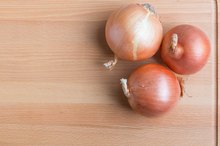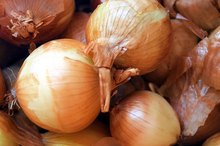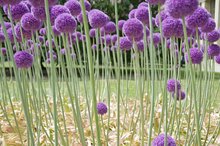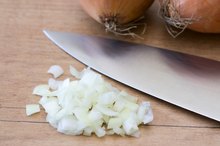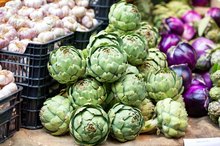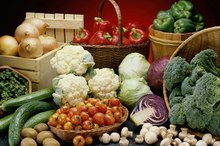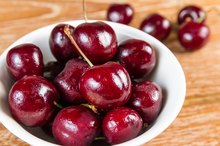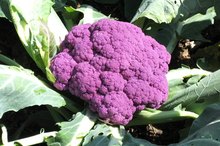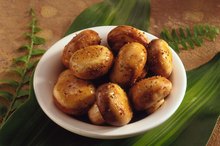Nutritional Difference Between Yellow & Red Onions
Major nutrients such as carbohydrates and vitamin C are generally similar from one color and variety of onion to another. Color and pungency, however, indicate the presence of beneficial anti-oxidants that do vary in amount and type with the onion variety. If you use both red and yellow onions, you can take advantage of the best qualities of each.
Storage Lifetimes
The best locally grown onions arrive at your supermarket in August, after the fully matured bulbs reach their peak nutritional content and go dormant. Bulb onions survive storage for three to six months, according to the Alabama Cooperative Extension 1. Yellow storage onions keep their nutritional qualities longer than mild red bulb onions because of higher levels of protective chemical compounds. These phytochemicals preserve the major nutrients in the onion bulb and prevent bulb rot. Phytochemicals also provide important health benefits.
- The best locally grown onions arrive at your supermarket in August, after the fully matured bulbs reach their peak nutritional content and go dormant.
- These phytochemicals preserve the major nutrients in the onion bulb and prevent bulb rot.
Flavonoids
Carbohydrates and Fiber in Onions
Learn More
Differences in the nutritional content of onions arise as the bulbs mature 2. Yellow storage onions develop tough-skinned pungent bulbs with high levels of anti-oxidant phytochemicals. Phytochemicals such as phenolics and flavonoids protect onions from fungal diseases, viruses and bacteria. Onions with greater pungency have higher levels of these anti-oxidants. Of the 10 most common onion varieties sold in the United States, Western Yellow onions rank highest in flavonoids, according to an article published in 2004 in the Journal of Agricultural and Food Chemistry 3. Northern Red onions rank fourth. Western Yellow onions rank second in overall anti-oxidant activity, while Northern Red onions again rank fourth.
Anthocyanins
Red vegetables including red onions contain phytochemicals with unique anti-oxidant properties. Chemical compounds such as lycopene and anthocyanin give onions a red or reddish purple color. These anti-oxidants help prevent cholesterol from sticking to the walls of your arteries. Other health benefits include better memory and fewer urinary tract infections. Further, Western Yellow and Northern Red onions contain high amounts of anti-oxidants that slow the growth of cancer cells in the liver and the colon, according to the 2007 issue of the "Journal of Agricultural and Food Chemistry. 3"
- Red vegetables including red onions contain phytochemicals with unique anti-oxidant properties.
- Further, Western Yellow and Northern Red onions contain high amounts of anti-oxidants that slow the growth of cancer cells in the liver and the colon, according to the 2007 issue of the "Journal of Agricultural and Food Chemistry.
Variety Choices
Do Onions Thin Blood?
Learn More
Supermarkets typically carry a limited selection of the many varieties of onions that are grown around the world. If you grow your own produce, try some varieties that offer better nutritional value than the commercial offerings. Pungency and color mark the qualities needed for high anti-oxidant levels in onions, so choose varieties known for long storage lifetimes rather than mild sweet flavor. Plant darker types of red onions for higher anthocyanin content. Short-day-length onions grow best in the southern United States, but long-day-length onions grow better in northern climates. Ask your extension agent for advice on the best choices for your region.
- Supermarkets typically carry a limited selection of the many varieties of onions that are grown around the world.
- Pungency and color mark the qualities needed for high anti-oxidant levels in onions, so choose varieties known for long storage lifetimes rather than mild sweet flavor.
Related Articles
References
- Alabama Cooperative Extension System: Growing Onions
- Journal of Agricultural and Food Chemistry: Varietal Differences in Phenolic Content and Antioxidant and Antiproliferative Activities of Onions
- Journal of Agricultural and Food Chemistry: Onions: A Source of Unique Dietary Flavonoids
- Agricultural Marketing Resource Center: Onion Profile
- University of Illinois Extension: Watch Your Garden Grow -- Onion
- Onions, raw. FoodData Central. U.S. Department of Agriculture. Published April 1, 2019.
- Anderson GH, Soeandy CD, Smith CE. White vegetables: Glycemia and satiety. Adv Nutr. 2013;4(3):356S-67S. doi:10.3945/an.112.003509
- Exploring aromatics. Academy of Nutrition and Dietetics. Updated 2020.
- Dabeek WM, Marra MV. Dietary quercetin and kaempferol: Bioavailability and potential cardiovascular-related bioactivity in humans. Nutrients. 2019;11(10). doi:10.3390/nu11102288
- Puccinelli MT, Stan SD. Dietary bioactive diallyl trisulfide in cancer prevention and treatment. Int J Mol Sci. 2017;18(8). doi:10.3390/ijms18081645
- Marrelli M, Amodeo V, Statti G, Conforti F. Biological properties and bioactive components of Allium cepa L.: Focus on potential benefits in the treatment of obesity and related comorbidities. Molecules. 2018;24(1). doi:10.3390/molecules24010119
- Chae MR, Kang SJ, Lee KP, et al. Onion (Allium cepa L.) peel extract (OPE) regulates human sperm motility via protein kinase C-mediated activation of the human voltage-gated proton channel. Andrology. 2017;5(5):979-989. doi:10.1111/andr.12406
- Smith AP, Sutherland D, Hewlett P. An investigation of the acute effects of oligofructose-enriched inulin on subjective wellbeing, mood and cognitive performance. Nutrients. 2015;7(11):8887-96. doi:10.3390/nu7115441
- Albanesi M, Pasculli C, Giliberti L, et al. Immunological characterization of onion (Allium cepa) allergy. Postepy Dermatol Alergol. 2019;36(1):98-103. doi:10.5114/ada.2019.82829
- Cooking with onions without crying. University of Nebraska-Lincoln. Updated 2020.
- What is the low FODMAP diet?. Academy of Nutrition and Dietetics. Updated 2019.
- Onions. RxList. Updated 2019.
- Shock CC, Cheatham NE, Harden JL, Mahony, AC, Shock BM. Types of onions and varieties. Oregon State University. College of Agricultural Sciences. Updated 2020.
- Dowdy S. Stored properly Vidalia onions can still be around this winter. University of Georgia. College of Agriculture and Environmental Science. Updated 2019.
Writer Bio
James Young began writing in 1969 as a military journalist combat correspondent in Vietnam. Young's articles have been published in "Tai Chi Magazine," "Seattle Post-Intelligencer," Sonar 4 ezine, "Stars & Stripes" and "Fine Woodworking." He has worked as a foundryman, woodturner, electronics technician, herb farmer and woodcarver. Young graduated from North Seattle Community College with an associate degree in applied science and electronic technology.
